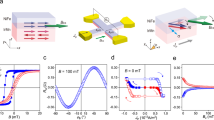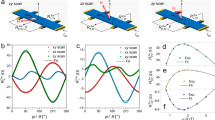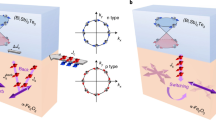Abstract
The electrical manipulation of magnetization and exchange bias in antiferromagnet/ferromagnet thin films could be of use in the development of the next generation of spintronic devices. Current-controlled magnetization switching can be driven by spin–orbit torques generated in an adjacent heavy-metal layer, but these structures are difficult to integrate with exchange bias switching and tunnelling magnetoresistance measurements. Here, we report the current-induced switching of the exchange bias field in a perpendicularly magnetized IrMn/CoFeB bilayer structure using a spin–orbit torque generated in the antiferromagnetic IrMn layer. By manipulating the current direction and amplitude, independent and repeatable switching of the magnetization and exchange bias field below the blocking temperature can be achieved. The critical current density for the exchange bias switching is found to be larger than that for CoFeB magnetization reversal. X-ray magnetic circular dichroism, polarized neutron reflectometry measurements and micromagnetic simulations show that a small net magnetization within the IrMn interface plays a crucial role in these phenomena.
This is a preview of subscription content, access via your institution
Access options
Access Nature and 54 other Nature Portfolio journals
Get Nature+, our best-value online-access subscription
$29.99 / 30 days
cancel any time
Subscribe to this journal
Receive 12 digital issues and online access to articles
$119.00 per year
only $9.92 per issue
Buy this article
- Purchase on Springer Link
- Instant access to full article PDF
Prices may be subject to local taxes which are calculated during checkout






Similar content being viewed by others
Data availability
The data that support the plots within this paper and other findings of this study are available from the corresponding author upon reasonable request.
References
Baltz, V. et al. Antiferromagnetic spintronics. Rev. Mod. Phys. 90, 015005 (2018).
Jungwirth, T., Marti, X., Wadley, P. & Wunderlich, J. Antiferromagnetic spintronics. Nat. Nanotechnol. 11, 231–241 (2016).
Wadley, P. et al. Electrical switching of an antiferromagnet. Science 351, 587–591 (2016).
Lau, Y. C., Betto, D., Rode, K., Coey, J. M. D. & Stamenov, P. Spin–orbit torque switching without an external field using interlayer exchange coupling. Nat. Nanotechnol. 11, 758–762 (2016).
Brink, A. et al. Field-free magnetization reversal by spin-Hall effect and exchange bias. Nat. Commun. 7, 10854 (2016).
Lin, P. H. et al. Manipulating exchange bias by spin–orbit torque. Nat. Mater. 18, 335–341 (2019).
Kimata, M. et al. Magnetic and magnetic inverse spin Hall effects in a non-collinear antiferromagnet. Nature 565, 627–630 (2019).
Chen, X. et al. Electric field control of Néel spin–orbit torque in an antiferromagnet. Nat. Mater. 18, 931–935 (2019).
Yan, H. et al. A piezoelectric, strain-controlled antiferromagnetic memory insensitive to magnetic fields. Nat. Nanotechnol. 14, 131–136 (2019).
Razavi, S. A. et al. Joule heating effect on field-free magnetization switching by spin–orbit torque in exchange-biased systems. Phys. Rev. Appl. 7, 024023 (2017).
Miron, I. M. et al. Current-driven spin torque induced by the Rashba effect in a ferromagnetic metal layer. Nat. Mater. 9, 230–234 (2010).
Miron, I. M. et al. Perpendicular switching of a single ferromagnetic layer induced by in-plane current injection. Nature 476, 189–193 (2011).
Liu, L. et al. Spin-torque switching with the giant spin Hall effect of tantalum. Science 336, 555–558 (2012).
Liu, L., Lee, O. J., Gudmundsen, T. J., Ralph, D. C. & Buhrman, R. A. Current-induced switching of perpendicularly magnetized magnetic layers using spin torque from the spin Hall effect. Phys. Rev. Lett. 109, 096602 (2012).
Baumgartner, M. et al. Dynamics driven by spin–orbit torques. Nat. Nanotechnol. 12, 980–986 (2017).
Zhang, W. & Krishnan, K. M. Epitaxial exchange-bias systems: from fundamentals to future spin–orbitronics. Mater. Sci. Eng. R 105, 1–20 (2016).
Schuller, I. K. Exchange bias. J. Magn. Magn. Mater. 192, 203–232 (1999).
Zhou, J. et al. Large spin–orbit torque efficiency enhanced by magnetic structure of collinear antiferromagnet IrMn. Sci. Adv. 5, eaau6696 (2019).
Zhang, W. et al. Giant facet-dependent spin–orbit torque and spin Hall conductivity in the triangular antiferromagnet IrMn3. Sci. Adv. 2, e1600759 (2016).
Wu, D. et al. Spin–orbit torques in perpendicularly magnetized Ir22Mn78/Co20Fe60B20/MgO multilayer. Appl. Phys. Lett. 109, 222401 (2016).
Ou, Y., Shi, S., Ralph, D. C. & Buhrman, R. A. Strong spin Hall effect in the antiferromagnet PtMn. Phys. Rev. B 93, 220405(R) (2016).
Zhang, W. et al. Spin Hall effects in metallic antiferromagnets. Phys. Rev. Lett. 113, 196602 (2014).
Fukami, S., Zhang, C., DuttaGupta, S., Kurenkov, A. & Ohno, H. Magnetization switching by spin–orbit torque in an antiferromagnet–ferromagnet bilayer system. Nat. Mater. 15, 535–541 (2016).
Oh, Y.-W. et al. Field-free switching of perpendicular magnetization through spin–orbit torque in antiferromagnet/ferromagnet/oxide structures. Nat. Nanotechnol. 11, 878–884 (2016).
Reichlová, H. et al. Current-induced torques in structures with ultrathin IrMn antiferromagnets. Phys. Rev. B 92, 165424 (2015).
Parkin, S. S. P. et al. Giant tunnelling magnetoresistance at room temperature with MgO(100) tunnel barriers. Nat. Mater. 3, 862 (2004).
Yuasa, S., Nagahama, T., Fukushima, A., Suzuki, Y. & Ando, K. Giant room-temperature magnetoresistance in single-crystal Fe/MgO/Fe magnetic tunnel junctions. Nat. Mater. 3, 868–871 (2004).
Pi, U. H. et al. Tilting of the spin orientation induced by Rashba effect in ferromagnetic metal layer. Appl. Phys. Lett. 97, 162507 (2010).
Kim, J. et al. Layer thickness dependence of the current-induced effective field vector in Ta|CoFeB|MgO. Nat. Mater. 12, 240 (2013).
Khvalkovskiy, A. V. et al. Matching domain-wall configuration and spin–orbit torques for efficient domain-wall motion. Phys. Rev. B 87, 020402 (2013).
Noguésa, J. et al. Exchange bias in nanostructures. Phys. Rep. 422, 65–117 (2005).
Stamps, R. L. Mechanisms for exchange bias. J. Phys. D: Appl. Phys. 33, 247268 (2000).
Meiklejohn, W. H. & Bean, C. P. New magnetic anisotropy. Phys. Rev. 105, 3 (1957).
Ohldag, H. et al. Correlation between exchange bias and pinned interfacial spins. Phys. Rev. Lett. 91, 1 (2003).
Fitzsimmons, M. R. et al. Pinned magnetization in the antiferromagnet and ferromagnet of an exchange bias system. Phys. Rev. B 75, 214412 (2007).
Dubowika, J. & Goscianska, I. Micromagnetic approach to exchange bias. Acta Phys. Pol. A 127, 147–152 (2015).
Maranville, B., Ratcliff, W. & Kienzle, P. reductus: a stateless Python data reduction service with a browser front end. J. Appl. Crystallogr. 51, 1500–1506 (2018).
Kirby, B. J. et al. Phase-sensitive specular neutron reflectometry for imaging the nanometer scale composition depth profile of thin-film materials. Curr. Opin. Colloid Interface Sci. 17, 44–53 (2012).
Vansteenkiste, A. et al. The design and verification of MuMax3. AIP Adv. 4, 107133 (2014).
Clercq, J. D., Vansteenkiste, A., Abes, M., Temst, K. & Waeyenberge, B. V. Modelling exchange bias with MuMax3. J. Phys. D: Appl. Phys. 49, 435001 (2016).
Leighton, C., Nogués, J., Åkerman, B. J. J. & Schuller, I. K. Coercivity enhancement in exchange biased system driven by interfacial magnetic frustration. Phys. Rev. Lett. 84, 3466–3469 (2000).
Grady, K., Outon, L. E. F. & Fernandez, G. V. A new paradigm for exchange bias in polycrystalline thin films. J. Magn. Magn. Mater. 322, 883–899 (2010).
Aley, N. P. et al. Texture effects in IrMn/CoFe exchange bias systems. IEEE Trans. Magn. 44, 2820–2823 (2008).
Rajua, M., Chaudhary, S. & Pandya, D. K. Magnetic annealing of the ion-beam sputtered IrMn/CoFeB bilayers—positive exchange bias and coercivity behavior. Eur. Phys. J. B 86, 491 (2013).
Acknowledgements
We thank the National Natural Science Foundation of China (grant nos. 61627813, 61571023), the International Collaboration Project B16001, the National Key Technology Program of China 2017ZX01032101 and the Beihang Hefei Innovation Research Institute Project BHKX-19-02 for their financial support of this work. This research used resources of the Advanced Light Source, a DOE Office of Science User Facility, under contract no. DE-AC02-05CH11231.
Author information
Authors and Affiliations
Contributions
W.Z. initialized, conceived and supervised the project. S.P. fabricated the devices. S.P., W.L., J.L., W.C. and D.X. performed the measurements. D.Z. performed the micromagnetic simulations. H.W. deposited the thin films under the supervision of K.L.W. A.J.G., D.A.G. and P.S. performed and analysed the X-ray spectroscopy and the neutron reflectometry. S.P., D.Z., A.J.G. and W.Z. wrote the manuscript. All authors discussed the results and implications.
Corresponding author
Ethics declarations
Competing interests
The authors declare no competing interests.
Additional information
Publisher’s note Springer Nature remains neutral with regard to jurisdictional claims in published maps and institutional affiliations.
Supplementary information
Supplementary Information
Supplementary Sections 1–12, Figs. 1–13 and refs. 1–8.
Rights and permissions
About this article
Cite this article
Peng, S., Zhu, D., Li, W. et al. Exchange bias switching in an antiferromagnet/ferromagnet bilayer driven by spin–orbit torque. Nat Electron 3, 757–764 (2020). https://doi.org/10.1038/s41928-020-00504-6
Received:
Accepted:
Published:
Issue Date:
DOI: https://doi.org/10.1038/s41928-020-00504-6
This article is cited by
-
Orbitronics: light-induced orbital currents in Ni studied by terahertz emission experiments
Nature Communications (2024)
-
Effective electrical manipulation of a topological antiferromagnet by orbital torques
Nature Communications (2024)
-
Electrical manipulation and detection of antiferromagnetism in magnetic tunnel junctions
Nature Electronics (2023)
-
Spintronics intelligent devices
Science China Physics, Mechanics & Astronomy (2023)
-
Angular Magnetic-Field-Dependent Tunneling Magnetoresistance Controlled by Electric Fields in an MTJ/PMN-PT Multiferroic Heterostructure
Journal of Electronic Materials (2023)



